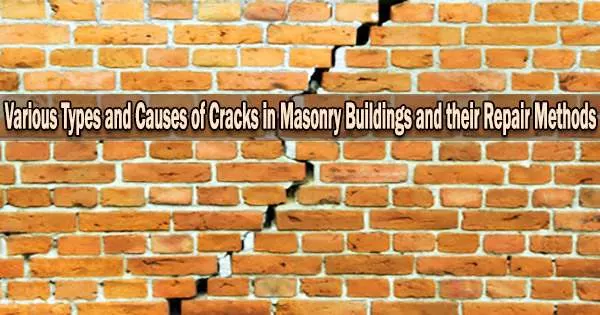There are numerous reasons why masonry buildings’ walls, foundations, slabs, and columns could break in different ways. There are some issues with structures that appear out of nowhere. Some issues, such as the development of cracks or foundation settlement, do not signal an impending danger. The majority of these issues are brought on by poor construction practices and negligence during initial construction. Therefore, taking care at an early stage might help avoid problems like these that necessitate heavy upkeep.
Causes and Types of Cracks in Masonry Buildings and their Repair Methods
The cracks appear in the masonry structure, at a certain period of time. Most commonly caused cracks with their respective causes and precaution, are explained below:
Cracks in Brick Mortar Joints
Brick mortar joints exhibit vertical or horizontal fractures. The sulfate attack, which weakens the mortar, is one of the primary causes. Usually, these fissures start to show up two to three years following construction. These cracks can be avoided by:
- Checking the sulfate content of bricks used in construction
- The damping of brick wall has to avoided, as these are more prone to sulfate attack when it is damp
Crack Formation Below the Load Bearing Walls
Below the load-bearing walls, particularly those that support R.C.C. slabs, cracks are seen. Now, changes in temperature cause the reinforced concrete slab to either expand or contract, but only horizontally. The topmost story, which is more exposed to temperature variations, is where these are seen. The wall and the slab do not touch smoothly. Because of this, frictional forces are created where the slab and wall meet. This creates cracking in the walls. Offering a bearing plaster over the brick wall, which aids in having a smooth contact with the floor above it, is a precaution that can be advised. If necessary, the plaster might be covered with a bituminous coating.
Main Wall and Cross Walls Joint Cracks
Improper bonding between the cross wall and the main wall creates cracks between the joints. This suggests us to have proper and quality bonding between the two walls. These are properly done by toothing.
Cracks Found in R.C.C Columns and Masonry
The differential movement of the columns and the masonry due to temperature difference is one of the primary causes of this. Depending on the temperature, this fluctuation can either be an expansion or a contraction. By creating a groove at the intersection of the reinforced concrete column and the masonry, these cracks can be concealed. This version may also benefit from the addition of chicken wire in place of plaster where columns and masonry meet.
The Horizontal cracks between R.C.C slab and the brick parapet
The non-projecting slab is mainly subjected to such cracks. This is a result of both drying shrinkage and temperature change. Small microcracks started to emerge and spread as the expansion or contraction increased. Making a groove at the masonry joint will help in disguising the cracks, which can be concealed. Another solution is to use chicken wire at the juncture where the plaster meets the wall.
Cracks in Roof Slab
Numerous cracks are caused by the roof slab’s exposure to greater temperature variations. By offering a training that is weatherproof, this can be decreased. There are new treatments and substances that can be used as a weather course and applied to the terrace.
Repair Methods for Cracks in Masonry Building Structural Members
Measures to be followed for already appeared cracks are:
- For cracks that have occurred in the main structural components, which must never be compromised at any cost, grouting or uniting must be used. Cement or an epoxy mixture are the materials most frequently employed for this. Epoxy has the capacity to fill cracks that are as thin as 0.1mm and are both small and wide. These epoxy gain high strength and adhesion.
- Cracks that have occurred on non-structural parts can be sealed with a flexible sealant. This aids in controlling the member’s differential movement (expansion or contraction) in response to changes in temperature.
- Cracks in plain cement concrete can be filled with epoxy putty, polymer filler, or lime cement mortar.
Measures for Foundation Settlement
The formation of cracks in the building is caused by the uneven settlement of the foundation caused by the variation in bearing capacity at different points of the building. The Certain preventive measure is:
- The foundation is planned to lay or hard soil
- Raising the wall and foundation gradually is necessary to allow for the structure’s permitted settlement.
- The settlement value of should not go beyond allowable, under any combination of loads.
- The foundation designed should facilitate uniformly distributed pressure on the soil.
Plinth Protection
By eliminating expansive soils like black soils (black cotton soil), nearby plinth, uneven settlement of plinth is prevented. Sand harries assist in maintaining this barrier. Rainwater can be kept away from the plinth by installing drains and erecting concrete barriers. It is necessary to prevent roots from penetrating the plinth. By halting the construction of neighbouring trees with lateral root systems, this can be avoided.
















